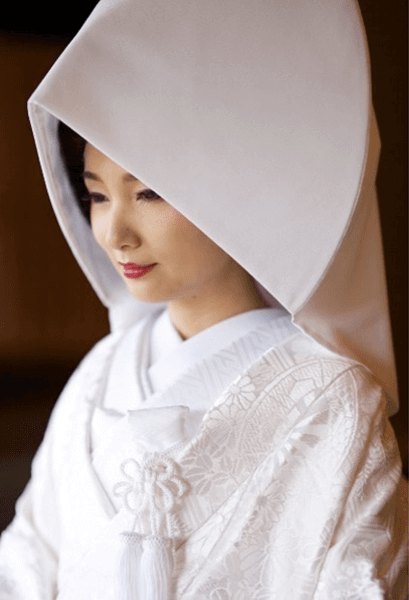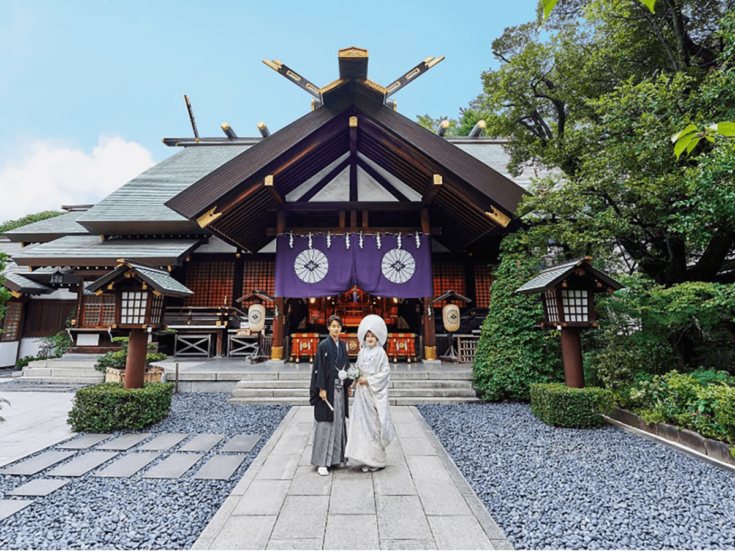If you were to have a wedding ceremony in Japan, would you prefer to have a Western-style wedding ceremony wearing a wedding dress or a Japanese-style wedding wearing a kimono? I suppose you can’t answer that without knowing what kind of kimono you would be wearing and how the ceremony would be conducted. So, I’d like to introduce to you what a Shinto wedding is and how it is full of traditional Japanese beauty. The ceremony varies from region to region and shrine to shrine, but I will use Tokyo Daijingu, is called Oise-sama お伊勢様 in Tokyo which is one of the five great shrines of Tokyo, as an example.
1. The Origin of the Shinto Wedding
Before the Meiji era, weddings in Japan were normally held in a traditional Japanese room with an alcove 床の間 in each home. However, the Shinto wedding ceremony began with the wedding of the crown prince (future Emperor Taisho) at a Shinto sanctuary in the Imperial palace in 1900. Since then, the Shinto wedding ceremony is believed to have been supported by many people, formalized, and spread throughout the country. However, it can be said that the reason for the remarkable spread of Shinto wedding ceremonies over the past 100 years is that the traditions and spirit of the ancient Japanese Shinto festivals have been passed down from generation to generation.
2. Japanese Wedding Costumes
1) Wedding Ceremony Costumes

◆The groom wears a black silk haori-hakama 羽織袴 with the family crest in five places on the back, both sleeves, and both sides of the chest, which is the formal attire. It is said that the color black means “not dyed in any color” and symbolizes the strong determination of the man who will be the mainstay of the family.
◆The bride wears a shiromuku 白無垢, a kimono worn and coordinated entirely in white, is considered the most prestigious wedding attire. Since the Muromachi period (1333-1573), daughters of samurai families have begun to wear it at their weddings. In addition, it is said that white was the costume of those who were available to the gods, and since “white” has the meaning of “purity” and “being dyed in the family style of the married family,” it was appropriate for a wedding ceremony to purge evil spirits and to attend a sacred ceremony, and so it took root. For its hairstyles, brides choose from the two types below.


◆Wataboshi 綿帽子: It is a hat-like object made of a large pure white cloth that covers the head and can only be worn when wearing a white kimono. It gives a dainty and profound impression. Under the wataboshi, the traditional Japanese hair is tied up in a bunkintakashimada 文金高島田.
◆Tsunokakushi 角隠し: The meaning of the word “tsunokakushi” is to hide the horns, which are a symbol of anger and jealousy, and it is meant to make her a demure wife. It refers to a long, thin piece of cloth that is wrapped around the hair that is tied into a bunkintakashimada. A kanzashi (hairpin) is added for a glamorous effect.
2) Wedding Reception Costumes

After wearing the shiromuku (white kimono) at the wedding ceremony, the bride wears a gorgeous kimono known as “oironaoshi お色直し”, meaning a change of clothes, at the wedding reception. There is a rule that iro-uchikake (colored kimono) must be worn after shiromuku, because it has the meaning of “becoming a member of the wedding family.” Iro-uchikake tend to be characterized by the depiction of cranes & turtles 鶴亀/turu-kame, phoenixes 鳳凰/houou, pine trees & bamboo & plum trees 松竹梅/sho-chiku-bai, as well as a court carriage 御所車, all of which are symbolic of the bride’s wish for happiness.
3.How to Proceed with the Ritual
1) Sanshin no Gi 参進の儀

Amidst the sounds of gagaku (traditional Japanese court music), the groom, bride, and their families walk through the shrine grounds to the shrine, led by Shinto priests 神主 and miko 巫女 (shrine maidens).
2) Shubatu 修祓

Before the ceremony, the Shinto priest performs the words of purification and purifies the groom and bride with hemp. During this time, everyone stands and bows their heads.
3) Saishu Ippai 斎主一拝
At the beginning of the ceremony, all the participants stand up and bow once in front of the gods with the priest.
4) Norito Soujyo 祝詞奏上
The Shinto priest performs the blessing, reports on the marriage, and prays for long-lasting happiness.
5) Sankon no Gi 三献の儀

This is also known as ”San-san-ku-do 三三九度.” The bride and groom, assisted by a miko, drink the sacred sake offered before the gods three times each from three different sake cups to seal their union as husband and wife.
6) Toyosaka no Mai 豊栄舞

Also known as “Otome no Mai 乙女の舞” (maiden’s dance), this graceful dance is performed by four miko in dedication to the gods in celebration.
7) Seishi Sojyo 誓詞奏上

The groom and the bride proceed in front of the gods and the groom reads his vows, expressing their gratitude for having met one another by God’s guidance, and their marriage vows.
8) Tamagushi Hairei 玉串拝礼

The bride and groom offer a branch of sakaki 榊 called a “tamagushi 玉串” and bow in the manner of “nirei-nihakushu-ichirei 二礼二拍手一礼 (two bows, two claps, one bow)” as an expression of gratitude and prayer. It is said that through the tamagushi, thoughts and feelings are conveyed to the gods.
9) Yubiwa Kokan 指輪交換 (Exchanging rings)

Originally a Western custom, it was adapted to meet the needs of the times.
10) Toyohogi no Mai 豊寿舞

This is a celebration dance unique to the Tokyo Grand Shrine. A miko dressed in a butterfly costume performs a festive dance to the accompaniment of a wedding song given by the former Ise Jingu priest.
11) Shinzoku Sakazuki no Gi 親族盃の儀
All relatives of both families receive sake and perform a ceremony to cement the relationship.
12) Saishu Ichirei 斎主一礼
Everyone rises to face the shrine, bow once, and the ceremony is over.
4. Chance to See a Wedding
If you want to see a Shinto wedding with your own eyes, visit the big shrines, such as the Tokyo-daijinngu 東京大神宮, Meiji-jingu 明治神宮, etc. You’ll be able to see a part of the wedding ceremony. However, in Japan, the day of the wedding tends to be determined by rokuyou 六曜, which is a type of calendar believed to have come from China that indicates the auspiciousness of the day. If you visit on a day such as Taian 大安 or Tomobiki 友引, and not Butumetu 仏滅, you will have a better chance of seeing a wedding.
Final thought
On a personal note, my inspiration for this article was my son’s Shinto wedding at Tokyo-daijingu. In fact, I was moved by the experience of an ancient, richly traditional wedding ceremony at the shrine. I hope you understand the significance and form of a shinto wedding ceremony. Thanks for reading to the end.
Business training instructor. I’m originally from Takarazuka in Hyogo Prefecture in the Kansai area. Now I live in Yokohama. I love exercising, traveling, watching movies, art, and nature.





 HTJ has a YouTube page! Check it out
HTJ has a YouTube page! Check it out